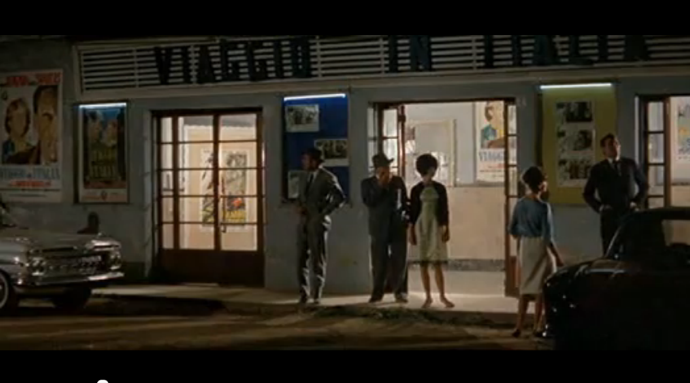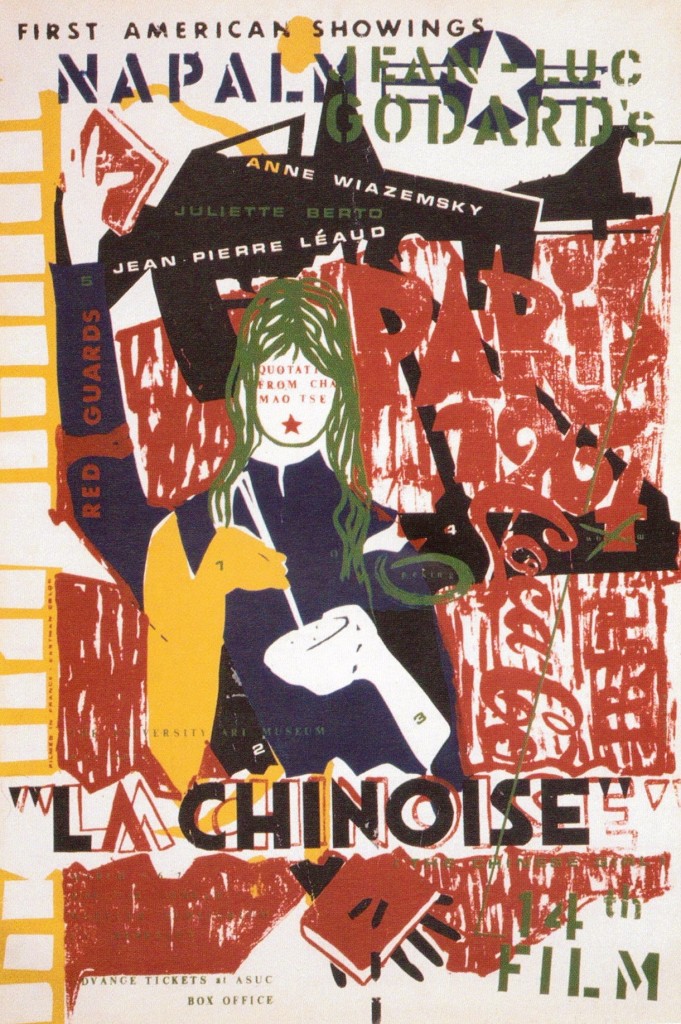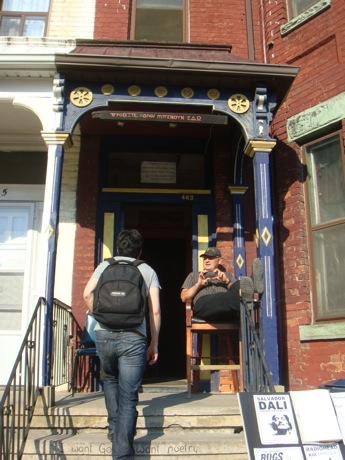Jun 2, 2013 0
Dec 12, 2012 0
Notable Marquees in Movies
In Contempt (Jean-Luc Godard, 1963), we spot a marquee for Rossellini’s Journey to Italy (1954). Very subtle, Jean-Luc!
Can you think of any other notable movie marquees in films? I’m especially interested in marquees that seem to fade into the background or appear as part of the mise-en-scène for no particular reason.
Nov 30, 2012 0
All I want for Christmas…
Jul 21, 2012 0
Qui? Quoi? Quand? Ou…. ?
Here is a poster for the movie Les Vampires by Louis Feuillade. It is a signed lithograph currently on display as part of the permanent exhibition at the Cinematheque Francaise. Fun fact: the actress Musidora depicted here actually worked at the ticket booth at the Cinematheque Francaise until 1943.
Musidora, who not only starred in films but also directed and produced them, is worthy of a blog post in her own right (and a New York City retrospective for my money). Here’s a brief glimpse from Soleil et Ombre [1922], one of the two films that she directed that has survived:
Jun 29, 2012 1
Reg Hartt’s Cineforum
When I visited Toronto this past June, I had the pleasure of stopping by Reg Hartt’s Cineforum, a legendary microcinema that screens everything from subversive shorts by Salvador Dali to Hollywood rarities. The theater manages to stay on the radar of most Torontonians thanks to aggressive postering campaigns, how I initially learned of its existence. The venue is the polar opposite of the shiny new TIFF Bell Lightbox, Toronto’s state-of-the-art cinematheque and home of the Toronto Film Festival. Yet each venue is, in its own way, a temple to cinema—and I think true lovers of film appreciate that Toronto is lucky enough to have both.
The Cineforum is bit off the beaten path, located on nondescript stretch of Bathurst street (just a short trolley ride away from the now-trendy Ossington Avenue). When one walks up the steps, she is greeted by the founder himself, and this quote by Aldous Huxley:
Inside, the Cineforum is a ramshackle wonderland of memorabilia, complete with vintage film posters (many of them painted by Hartt himself), books, movie swag, Frankenstein heads, and more.

The films are for the most part projected on DVD. Here’s Reg Hartt firing up the projector.
What’s truly special about the Cineforum is the programming: an idiosyncratic mix of high and low, with a proclivity towards subculture/countercultural cinema and lots of undeground oddities thrown in. When I was there, I saw a documentary portrait of Jane Jacobs, which seemed appropriate—because the lively eccentricity of the Cineforum is something Jacobs would advocate for (and in fact, she and Reg Hartt were friends).
I spoke with Reg Hartt for a spell about his reasons for starting the Cineforum, which if you haven’t gathered, is run out of his own house. He said he quit programming for another theater when they told him he couldn’t screen a certain film, and so he started his own screening series as a result. The Cineforum has been an eclectic and necessary fixture of Toronto ever since.
Jan 26, 2012 1
CATS IN BAG BAGS IN RIVER [Christopher Wool, 1990]
Let’s get down to brass tacks: there are few things I love more than hardboiled film noir dialogue—that outrageous, rapid-fire back-and-forth smothered in pulp and peppered with slang. It’s a major source of the genre’s appeal, cloaking the film in the seedy, coded vernacular of the underworld. The tough talk in The Sweet Smell of Success represents a particular apogee of the form, and the neurotically articulate screenplay is chock-full of colorful metaphors, New York argot, and punchy one-liners. Some of the most memorable: “You’re a cookie full of arsenic,” “Just don’t leave me in a minor key,” “You’re dead son, get yourself buried” and “The cat’s in the bag and the bag’s in the river.”
Which brings us to Christpher Wool. This fine example of Wool’s language-based painting is now on view at MoMA as part of their current refresh of the Contemporary Galleries, and its visual impact is akin to that of a New York Post headline: graphic, sensational, and not overly predisposed to subtlety. Wool appropriates this evocative line from the film, shortens it like a text message, and then stencils it imperfectly in pump-em-full-of-lead-black on a stark white background. CATS INBAG BAGS IN RIVER suddenly morphs into a puckish haiku, a expression of hardnosed lyricism. Sidney Falco, the character who utters this juicy bit of repartee in the film, is someone that we come to admire for his gumption in doing away with the competition, and his cockiness has a comic edge. This painting too, manifests a certain biting humor, a humor that mocks the seriousness of painting and pays tribute to all of the sinister smart guys in the room—of which Christopher Wool is one.
Here’s Mr. Falco himself, aka Tony Curtis, delivering the line full of piss, vinegar and snarling ambition. Don’t be a two-time loser: see this classic if you haven’t already, and then check out this painting in person.
Dec 11, 2011 3
The Death and Life of 35mm
Though reports of the death of 35mm have been rumored for some time now, the death knell has officially sounded in the form of a report from the IHS Screen Digest Cinema Intelligence Service, which marks 2012 as the year that digital technology will overtake 35mm projection.
What does this mean? For the first time in cinema’s 120 years, analogue film will no longer be the norm, but the exception. 35mm projectors will likely disappear from theaters by 2015. The technology and equipment required for 35mm filmmaking will be accessible only to a privileged few. And a treasure trove of 35mm prints will be left to rot in a vault somewhere, save for a few deemed worthy of preservation by a handful of film archives. Repertory houses who are devoted to the format will continue to the screen 35mm until distribution ceases. Most moviegoers will never notice the difference.
But there is a difference. Film is an index and retains a physical impression from its exposure to light, while digital movies are composed from a finite number of pixels. The fact that digital imitates film is purely superficial, and in fact, they undergo drastically different mechanical processes. Digital cameras record a series of 0s and 1s to create an approximation of a photograph, whereas the film camera catalyzes a chemical reaction between light and film stock.
There is also detectable difference in the look and feel of the two mediums. Digital is often noticeably digital: spotless, precise, or at worst, grotesquely pixelated. Whereas film has a certain texture that closer to the smoothness of a painting. The blacks are richer and have more depth, and actors’ faces are warmer and suffused with light. Digital is glacial, flat, and sterile-looking, and 35mm is full-bodied and radiant.
The shift to digital also disproportionately affects the distribution of older films, which were shot on 35mm with the intention of projecting that way. Many studios have said that they will stop producing 35mm prints of older films for use in repertory cinemas, and instead present those films only in digital formats. For serious film lovers, this is unthinkable.
The British artist Tacita Dean has mounted an incredibly eloquent protest in the Turbine Hall of the Tate Modern. Simply called Film, her installation is an elegaical plea for the continuation and the preservation of the medium. A short film in which she captures the legendary green ray (yes, that same rayon vert at the end of the eponymous Rohmer film) is perhaps the most poetic raison d’être for film—real film—that I’ve encountered.
I’m not dead
I’m merely changing places
I am still with you
In dreams you’ll see my traces
—Michelangelo
Nov 28, 2011 1
The Striped Shirt in Cinema
If you routinely draw your fashion inspiration from films (as I do), you’ll notice that one classic item of clothing keeps appearing over and over: the sailor-striped shirt. Known alternately as the marinière, the Breton shirt, and the telnyashka in Russia, the simple white and navy blue pullover is an iconic fashion piece with international appeal. Originally created for the French navy—the stripes helped spot seamen who had gone overboard—the style was co-opted by Coco Chanel, and the rest is fashion history. Perhaps it’s no surprise that the shirt has been equally prominent onscreen: its graphic horizontal stripes read well on film, and both the masculin and the féminine look good in it. Below are some of my favorite striped-shirt in cinema moments:

Zouzou [Allégret, 1934]. Jean Gabin sports the classic French naval uniform while Josephine Baker dons the pom-pom hat.

Intermezzo [Ratoff / Selznick, with cinematography by Gregg Toland, 1939]. Leslie Howard is a virtuoso violinist in a sailor shirt? Of course Ingrid Bergman would swoon.

Breathless [Godard, 1960]. A bit of graphic wit from Godard: Jean Seberg and Jean-Paul Belmondo’s stripes go up, down, and across.

Jules and Jim [Truffaut, 1962] Jeanne Moreau looks blissful in this perfect-for-cycling sweater.

Death in Venice [Visconti, 1971] Björn Andrésen as the beautiful Tadzio wears the shoulder-buttoned version.

Coco Before Chanel [Fontaine, 2009] This one’s easy, but I do like the way the film immortalizes Coco’s borrowed-from-the-boys style.

This photo is not from a film, but is so awesome that I had to include it. Who wouldn’t want to be Gloria Vanderbilt surrounded by um, stripes in this photo? [From the 1954 “April in Paris†ball at the Waldorf-Astoria]
Of course, seeing all of this striated loveliness begs the question: where can one obtain the perfect sailor shirt, and the waves of cool that come with it? My secret source, which is not-so-secret anymore since this piece in the New York Times, is Kaufman’s Army Navy. Shopping at this chaotic, one-of-a-kind New York institution is an experience altogether unequalled.

Wearing my Russian naval shirt from Kaufman’s—perhaps the easiest piece of clothing I own.
If you don’t live in New York, I’m sad for you, but you can order the high-end French original from St. James, or the easier-on-the-wallet Russian version from I Sea Stripes. Both are authentic (because really, do you need another striped shirt from the Gap?) and evoke the effortless charm that only stripes can.
Nov 13, 2011 1
Why do foreign films have to be so foreign?
I found it – the utterly asinine and sexist beer commercial that Scorsese referred to this 1993 letter to the New York Times.The ad is obviously satirizing a Fellini film, and was part of a larger campaign with the tagline, “Why ask why? Try Bud Dry.”
Fostering willful idiocy as a sales tactic? Yup, sounds like America.
Nov 9, 2011 0
Cesare Zavattini on Wonder [Sequences of a Cinematic Life, 1970]
I love it when people send me things. Here is something a reader sent me yesterday, in response to my post about the novel and the subsequent film adaptation of Contempt.
No words we can write will ever change the age-old power of the vulgar interests that collaborate to distinguish the film from literature, creating two aesthetic systems and two moralities. We are content with the illusion that one day they will say: “from the very beginning, perhaps twenty individuals understood that the right wasn’t Hollywood’s, that the spectacle which began on the boulevards with the Lumière brothers was the beginning of the sickness.” The first theaters were called nickelodeons: a nickel was the price. And it was urgent to master the medium with a cost so low it could be within the reach of many individuals, like paper and ink, paints; film and lenses should have been brought into the home like sewing machines (then there would have been no producers, the apex of a bourgeois system, “applied” cinema, now defended, like a certain kind of publishing, by a wall of iron, the cliche about work being given to thousands of citizens). A return to man, to the creature who in himself is “all spectacle”; this would liberate us.
Set up the camera in a street, in a room, see with insatiable patience, train ourselves in the contemplation of our fellowman in his elementary actions. We will abandon trick photography, process shots, the infinite subterfuges so dear to Méliès. The wonder must be in us, expressing itself without wonder: the best dreams are those outside the mist, which can be seen like the veins of leaves.
—Cesare Zavattini




















